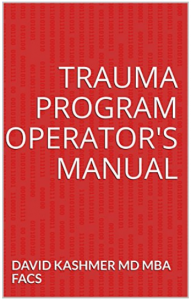But does trauma make money? I can’t tell you how tired I am of hearing this question.
If you’re ever in a situation where you have to justify the existence of your trauma program from a financial standpoint, good luck. Because if the program is not seen as a service to the community, it is very easy to question its financial performance.
The problem is that the way accounting is done and taught makes it tougher (but not impossible) to capture how trauma actually does “make money” in the U.S.
Below I’m going to describe a concept that is not taught in business schools or accounting classes, but explains why a good trauma program is a huge contributor to the financial health of your institution — the Case Mix Index (CMI) effect.
The Centers for Medicare & Medicaid Services (aka CMS) uses the CMI to determine the level of services your hospital is providing. It’s a measure of the average severity/complexity level of a hospital’s services. It’s an important factor in determining how much your hospital is reimbursed overall.
Don’t worry about how exactly the CMI is calculated, but know this: the CMI is a huge factor that lurks behind how trauma helps contribute to a hospital’s financial performance.
Once upon a time, I helped a Surgery Department turnaround situation where the CMI for the surgical services as a whole was 1.9. Now, let me tell you, that’s lloooowwww for surgical services. Really low.
We started a trauma and acute care surgery service, and only a few months later that CMI was 3.2. What did that mean to hospital reimbursement? Well, as a rule of thumb someone taught me a few years ago, an increase in the overall CMI by 0.2 (sustained over a year) is worth about one million dollars in revenue per year to a mid-sized hospital. So that 1.4 increase was probably worth about $5-7 million or so to the hospital if it was sustained over the next several years.
Your finance department may disagree with the exact numbers here, but I encourage you to get an idea from them about exactly what budging the CMI does for the hospital. Moving that number is dramatic in terms of how it helps the hospital. And you don’t hear it discussed often.
Guess why: CMI doesn’t just determine reimbursement for the trauma and ACS patients driving the increased severity, it helps determine reimbursement for all CMS patients at your institution. Wow.
But, of course, another important tip is that CMS doesn’t pay you for the CMI increase the same year it is occurring. It looks back on prior year’s performance and then starts to reimburse you. So if sustaining that new CMI costs you a ton of money, well, just make sure you can get that level achieved until the CMI effect kicks in later.
Now let me tell you this secret about trauma finance: hospitals really see a financial impact when they had a trauma program, but then closed or lost it for some reason. Nothing teaches a hospital system that trauma didn’t lose money better than when the trauma program disappears.
By the way, when was the last time you saw the CMI in the discussion about whether the trauma program “makes money”? Probably never. Or at least not often. But of course, much of what drives the CMI is the patients and procedures that trauma handles, such as tracheostomy procedures and critically ill patients on the ventilator.
Part of why you don’t see CMI at many of the discussions you have about trauma finance in your hospital is because it’s tough to say exactly which part and how much of the CMI is directly attributable to trauma. So that makes things a bit tougher to report. (But some centers do!)
So remember, the specter of the CMI looms large (and sometimes quietly) over every discussion of trauma finance. But CMI is not the only way trauma helps the hospital financially.
In my new book the Trauma Program Operator’s Manual, I explain how several important factors translate into your trauma program’s financial performance. Understanding these factors is the key to building a trauma program that delivers value no one can question.
David Kashmer, MD, MBA, FACS, a Trauma and Acute Care Surgeon, is a Fellow of the American College of Surgeons and a nationally known healthcare expert. He serves as a member of the Board of Reviewers for the Malcolm Baldrige National Quality Award. Dr. Kashmer is a Lean Six Sigma Master Black Belt with expertise in healthcare quality improvement.
His new book, the Trauma Program Operator’s Manual, explains the innermost workings of trauma and acute care surgery programs — specialized information that is essential to trauma leaders, but difficult to find and hard to acquire. With this book in hand, trauma medical directors, trauma program managers, hospital administrators and others will be able to rapidly accelerate their trauma and acute care surgery program in terms of maturation, quality improvement and financial sustainability.
The Trauma Program Operator’s Manual is available on Amazon — to get your copy, click here.


